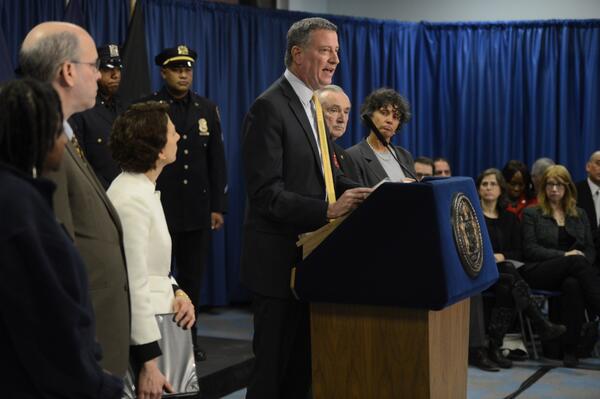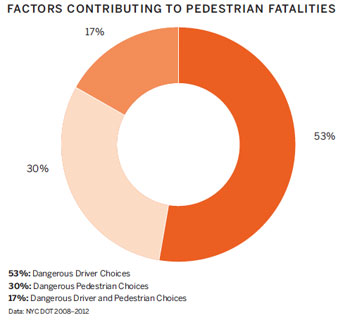
Mayor Bill de Blasio and several of his agency commissioners released the administration's Vision Zero report at a school on West End Avenue this afternoon. Streetsblog's Stephen Miller will have more from the mayor's event later today. In the meantime, here's a quick rundown of the major takeaways from the report [PDF], which outlines both an ambitious multi-agency approach to reducing traffic violence that City Hall can pursue on its own, and a legislative agenda that asks Albany to let the city control its speed limits and traffic enforcement methods.
Like the January press conference launching the Vision Zero initiative, today's announcement is first and foremost a sign that de Blasio is putting a high priority on reducing traffic deaths and injuries. The report, produced by a task force that de Blasio convened last month, rededicates NYC DOT to designing safer streets and brings NYPD on board in a big way, committing to increase traffic enforcement at the precinct level with more officers, modern technology, and better training. It also outlines several steps the Taxi and Limousine Commission can take to reduce dangerous behavior by for-hire drivers, and highlights how the city can operate its massive vehicle fleets with safety firmly in mind.
The report has a multi-pronged Albany agenda, including home rule over the allocation of automated enforcement cameras, which de Blasio campaigned on. The state legislature puts up a fight every time NYC asks for greater control over speed cameras and red light cameras, but the appeal from City Hall has never had quite this high a profile. It appears that the mayor's street safety agenda in the state capitol is not going to get drowned out by his other Albany priorities.

While these recommendations are more specific and wide-ranging than what de Blasio's team produced during the mayoral campaign, the administration is leaving room to refine and build on the ideas in the report, which it calls "just a beginning." A permanent Vision Zero task force, "comprised of the key agencies and partners needed to implement and extend this plan," will report to the Mayor's Office of Operations.
In an introductory letter to the report, de Blasio affirms that "the fundamental message of Vision Zero is that death and injury on city streets is not acceptable, and that we will no longer regard serious crashes as inevitable." He asks New Yorkers "to talk to your neighbors, speak up at community boards and block associations, and help foster a broader understanding that it is within our power to prevent tragedies on our streets."
Here are some of the more notable recommendations and factoids from the report:
- The administration will seek to reduce the citywide speed limit to 25 mph by having Albany modify section 1643 of the State Vehicle and Traffic Law.
- In an apparent corrective to Bill Bratton's assertion last month that pedestrians are at fault in most collisions, the report says that according to the last five years of data, motorists are mainly culpable for 53 percent of pedestrian fatalities in NYC and shared culpability for an additional 17 percent. Pedestrians were found to be mainly culpable in 30 percent of fatal crashes.
- NYPD is going to upgrade its speed detection equipment and increase speeding enforcement at the precinct level.
- The Collision Investigation Squad, which until recently did not investigate traffic crashes unless a victim was deemed "likely to die," will examine all crashes with critical injuries.
- In addition to de Blasio's previously stated goals to redesign "50 intersections and corridors" and roll out more neighborhood 20 mph zones, the report calls specifically for changes to the city's widest, most car-oriented streets with the creation of "25 new arterial slow zones" and adjustments to traffic signals on arterial streets. It would have been good to see an explicit commitment to more busways and bikeways, which reduce injuries both through design and by shifting trips to safer modes, but the report basically reaffirms NYC DOT's approach to safety-focused redesigns and adds a few new wrinkles.
- The section on the TLC calls for numerous measures to improve the training, monitoring, and enforcement of for-hire drivers, including a new "TLC safety enforcement squad, equipped with speed radar equipment, to enforce speed and safety regulations." Pilot programs for in-vehicle technology would alert "passengers and drivers that they are traveling over the speed limit" and, potentially, limit vehicle speeds or reduce fares when the driver speeds.
- The city operates huge fleets with thousands of vehicles, and the report says all of them should be "equipped with technology that record speeding and other dangerous driving behaviors, by the end of 2014."
Stay tuned for Stephen's report later this afternoon.





